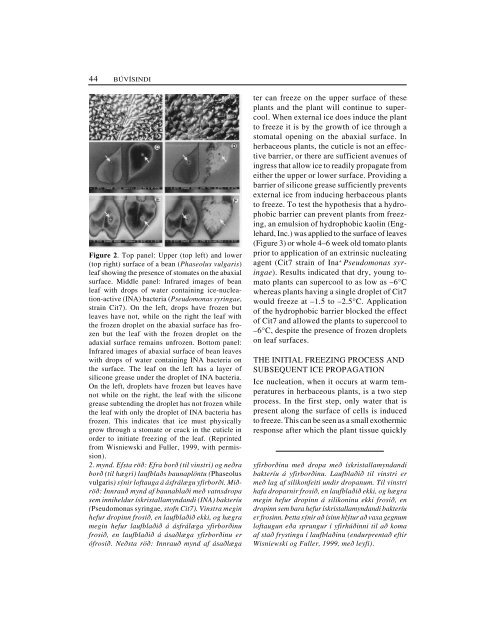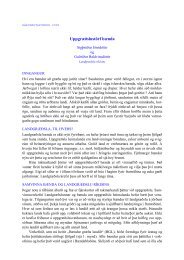Factors involved in ice nucleation and propagation ... - Landbunadur.is
Factors involved in ice nucleation and propagation ... - Landbunadur.is
Factors involved in ice nucleation and propagation ... - Landbunadur.is
You also want an ePaper? Increase the reach of your titles
YUMPU automatically turns print PDFs into web optimized ePapers that Google loves.
44 BÚVÍSINDI<br />
Figure 2. Top panel: Upper (top left) <strong>and</strong> lower<br />
(top right) surface of a bean (Phaseolus vulgar<strong>is</strong>)<br />
leaf show<strong>in</strong>g the presence of stomates on the abaxial<br />
surface. Middle panel: Infrared images of bean<br />
leaf with drops of water conta<strong>in</strong><strong>in</strong>g <strong>ice</strong>-<strong>nucleation</strong>-active<br />
(INA) bacteria (Pseudomonas syr<strong>in</strong>gae,<br />
stra<strong>in</strong> Cit7). On the left, drops have frozen but<br />
leaves have not, while on the right the leaf with<br />
the frozen droplet on the abaxial surface has frozen<br />
but the leaf with the frozen droplet on the<br />
adaxial surface rema<strong>in</strong>s unfrozen. Bottom panel:<br />
Infrared images of abaxial surface of bean leaves<br />
with drops of water conta<strong>in</strong><strong>in</strong>g INA bacteria on<br />
the surface. The leaf on the left has a layer of<br />
silicone grease under the droplet of INA bacteria.<br />
On the left, droplets have frozen but leaves have<br />
not while on the right, the leaf with the silicone<br />
grease subtend<strong>in</strong>g the droplet has not frozen while<br />
the leaf with only the droplet of INA bacteria has<br />
frozen. Th<strong>is</strong> <strong>in</strong>dicates that <strong>ice</strong> must physically<br />
grow through a stomate or crack <strong>in</strong> the cuticle <strong>in</strong><br />
order to <strong>in</strong>itiate freez<strong>in</strong>g of the leaf. (Repr<strong>in</strong>ted<br />
from W<strong>is</strong>niewski <strong>and</strong> Fuller, 1999, with perm<strong>is</strong>sion).<br />
2. mynd. Efsta röð: Efra borð (til v<strong>in</strong>stri) og neðra<br />
borð (til hægri) laufblaðs baunaplöntu (Phaseolus<br />
vulgar<strong>is</strong>) sýnir loftauga á ásfrálægu yfirborði. Miðröð:<br />
Innrauð mynd af baunablaði með vatnsdropa<br />
sem <strong>in</strong>niheldur ískr<strong>is</strong>tallamynd<strong>and</strong>i (INA) bakteríu<br />
(Pseudomonas syr<strong>in</strong>gae, stofn Cit7). V<strong>in</strong>stra meg<strong>in</strong><br />
hefur drop<strong>in</strong>n frosið, en laufblaðið ekki, og hægra<br />
meg<strong>in</strong> hefur laufblaðið á ásfrálæga yfirborð<strong>in</strong>u<br />
frosið, en laufblaðið á ásaðlæga yfirborð<strong>in</strong>u er<br />
ófrosið. Neðsta röð: Innrauð mynd af ásaðlæga<br />
ter can freeze on the upper surface of these<br />
plants <strong>and</strong> the plant will cont<strong>in</strong>ue to supercool.<br />
When external <strong>ice</strong> does <strong>in</strong>duce the plant<br />
to freeze it <strong>is</strong> by the growth of <strong>ice</strong> through a<br />
stomatal open<strong>in</strong>g on the abaxial surface. In<br />
herbaceous plants, the cuticle <strong>is</strong> not an effective<br />
barrier, or there are sufficient avenues of<br />
<strong>in</strong>gress that allow <strong>ice</strong> to readily propagate from<br />
either the upper or lower surface. Provid<strong>in</strong>g a<br />
barrier of silicone grease sufficiently prevents<br />
external <strong>ice</strong> from <strong>in</strong>duc<strong>in</strong>g herbaceous plants<br />
to freeze. To test the hypothes<strong>is</strong> that a hydrophobic<br />
barrier can prevent plants from freez<strong>in</strong>g,<br />
an emulsion of hydrophobic kaol<strong>in</strong> (Englehard,<br />
Inc.) was applied to the surface of leaves<br />
(Figure 3) or whole 4–6 week old tomato plants<br />
prior to application of an extr<strong>in</strong>sic nucleat<strong>in</strong>g<br />
agent (Cit7 stra<strong>in</strong> of Ina + Pseudomonas syr<strong>in</strong>gae).<br />
Results <strong>in</strong>dicated that dry, young tomato<br />
plants can supercool to as low as –6°C<br />
whereas plants hav<strong>in</strong>g a s<strong>in</strong>gle droplet of Cit7<br />
would freeze at –1.5 to –2.5°C. Application<br />
of the hydrophobic barrier blocked the effect<br />
of Cit7 <strong>and</strong> allowed the plants to supercool to<br />
–6°C, despite the presence of frozen droplets<br />
on leaf surfaces.<br />
THE INITIAL FREEZING PROCESS AND<br />
SUBSEQUENT ICE PROPAGATION<br />
Ice <strong>nucleation</strong>, when it occurs at warm temperatures<br />
<strong>in</strong> herbaceous plants, <strong>is</strong> a two step<br />
process. In the first step, only water that <strong>is</strong><br />
present along the surface of cells <strong>is</strong> <strong>in</strong>duced<br />
to freeze. Th<strong>is</strong> can be seen as a small exothermic<br />
response after which the plant t<strong>is</strong>sue quickly<br />
yfirborð<strong>in</strong>u með dropa með ískr<strong>is</strong>tallamynd<strong>and</strong>i<br />
bakteríu á yfirborð<strong>in</strong>u. Laufblaðið til v<strong>in</strong>stri er<br />
með lag af silikonfeiti undir dropanum. Til v<strong>in</strong>stri<br />
hafa droparnir frosið, en laufblaðið ekki, og hægra<br />
meg<strong>in</strong> hefur drop<strong>in</strong>n á silikon<strong>in</strong>u ekki frosið, en<br />
drop<strong>in</strong>n sem bara hefur ískr<strong>is</strong>tallamynd<strong>and</strong>i bakteríu<br />
er fros<strong>in</strong>n. Þetta sýnir að ís<strong>in</strong>n hlýtur að vaxa gegnum<br />
loftaugun eða sprungur í yfirhúð<strong>in</strong>ni til að koma<br />
af stað fryst<strong>in</strong>gu í laufblað<strong>in</strong>u (endurprentað eftir<br />
W<strong>is</strong>niewski og Fuller, 1999, með leyfi).
















